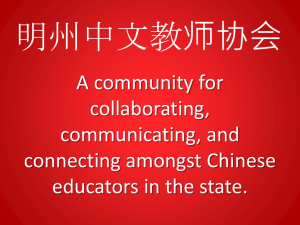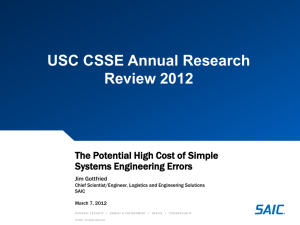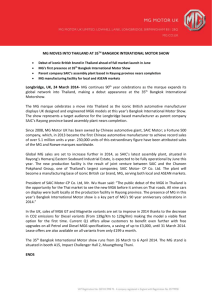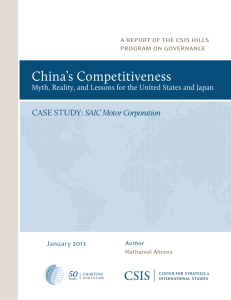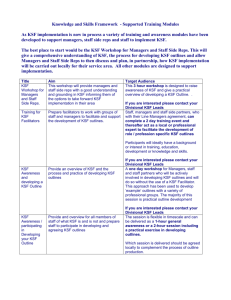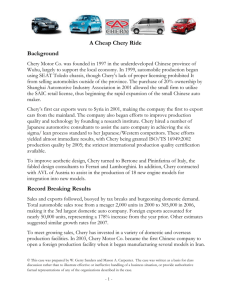Contents - Knowledge
advertisement
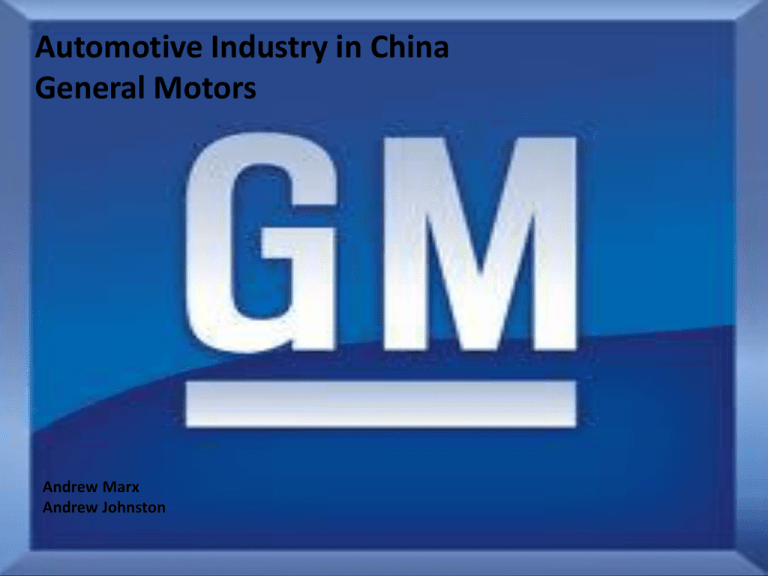
Automotive Industry in China General Motors Andrew Marx Andrew Johnston Contents Intro & Background Entry into China Competitive View KSF’s & Industry Trends Chinese Market Features - Impact on GM Challenges What we want you to Remember Vision of General Motors "GM’s vision is to be the world leader in transportation products and related services. We will earn our customers’ enthusiasm through continuous improvement driven by the integrity, teamwork, and innovation of GM people." Company Introduction • • • • • • • • • • • One of the world's largest automakers was founded in 1908. Global headquarters in Detroit 208,000 employees in 157 countries and produces cars and trucks in 31 countries GM Brands: Buick, Cadillac, Chevrolet, GMC, Daewoo, Holden, Jiefang(FAW), Opel, Vauxhall and Wuling(SGMW). Vehicles Manufactured Locally through Shanghai GM (JV with SAIC) The Shanghai GM plant December 15 1998 (Buick first) JV with SAIC and Wuling (microvans and 34 percent owned by GM) In August 2009 JV with FAW to produce LDCV, and produces Jiefang GM increased its sales in China by 68 percent to 230,048 vehicles in March 2010, outsold its U.S. sales of 188,546 by 22 percent. GM Research and Technology Centre in Shanghai with SAIC, Green innovation The last emperor of China owned a Buick (Strong Brand Recognition) Contents Intro & Background Entry into China Competitive View KSF’s & Industry Trends Chinese Market Features - Impact on GM Challenges What we want you to Remember Why JV as Entry Strategy? • Required by Government • GM Shanghai formed through JV with SAIC in 1997 • SAIC Motor Corp. Ltd. is the largest listed vehicle company in the Chinese A-share stock market. • The main business SAIC include R&D, production and sales of vehicles (including passenger and commercial vehicles) and components closely related with vehicle development (including powertrains, chassis, electronics and electric parts) • SAIC player in automotive finance business • In 2009, SAIC Motor sold more than 2.72 million vehicles, continuing its leading position among major automotive groups in China. GM sold 1 001 360. • JV makes good business sense (Cultural divide, access to market, technology sharing and innovation) • Very successful due to mutually beneficial relationship NB! Recent Developments • General Motors (GM) SAIC announced a joint powertrain development program. Small displacement (1.0-1.5-liter) engines and a matching dual-clutch automatic transmission • Splitting development costs • Produce an engine/tranny combination that is 20 percent more efficient • The new powerplants will be both direct injected and turbocharged to create a 10 percent boost in fuel economy • Partnership builds on long history of innovation and collaboration • Small displacement gasoline engine family targets heart of market Contents Intro & Background Entry into China Competitive View KSF’s & Industry Trends Chinese Market Features - Impact on GM Challenges What we want you to Remember Top 10 Competitors in China General Motors Sales in ‘09 in China 8% 7% Shanghai VW 7% 15% 8% 9% 9% Chery 17% BYD Beijing Hyundai FAW VW 10% 10% Dongfeng Nissan Manufacturer Sales FAW TO 1. General Motors 1001360 Geely 2. Shanghai VW 876 180 3. Chery 605 260 Guangoi Honda 4. BYD 601 500 5. Beijing Hyundai 541 430 6. FAW VW 526 660 7. Dongfeng Nissan 494 090 8. FAW Toyota 453 280 9. Geely 390 630 10. Guangqi Honda 379 450 In 2010 GM has sold 1,976,913 units, selling 200 000 units in the month of October alone Market Information 7% 1. Shanghai GM 5% 6% 2. Shanghai VW 4% 3. Chery 4% Market Share 4. BYD 5. Beijing Hyundai 57% 4% 3% 3% 4% 3% 6. FAW VW 7. Dongfeng Nissan 8. FAW Toyota 9. Geely 10. Guangqi Honda Other 42 2009 GM Owned 46% share of Small cars 6% Car Type model Mix 5% 41% 21% Small Cars Basic' Cars Mid-Size Sedans 27% MPV's SUV's Products in the Chinese Market JV with FAW: Jiefang The Jiefang brand from FAW-GM, GM’s light commercial vehicle joint venture, is showing its newest product Strategic Differentiation Suppliers • • • • • • • • Suppliers of Vital importance (Quality and Cost) Relationships are key Conflicting Interests JV comes in handy (SAIC produces parts, and well connected in industry) Quality and low cost parts result in cheaper better cars Proximity is key (lower distribution costs) Reliable Low bargaining Power Primary Activities Internal Value Chain Analysis Secondary Activities Administration & Infrustructure (Accounting) Function Human Resources Management Dealer & Supplier relations Management Research & Product Design Manufactu -ring of Parts Assembling & Operations Supply chain mangage -ment Marketing & Sales Customer Service Contents Intro & Background Entry into China Competitive View KSF’s & Industry Trends Chinese Market Features - Impact on GM Challenges What we want you to Remember Key Success Factors Industry Success Factors Importance Rating GM’S Score Competitive Advantage Low Operating and Production Costs 8 8 MEDIUM R&D 7 10 MEDIUM Economies of Scale 10 7 MEDIUM Guangxi - Employee relationships, satisfaction, retention, productivity 8 9 MEDIUM Good Dealer Network 10 10 YES Brand Recognition and Reputation 8 8 MEDIUM Fuel efficiency 10 10 MEDIUM Understanding Customer needs 10 10 YES Broad Product Range 6 10 YES Quality and Reliability 10 10 MEDIUM Partnerships and JV’s 10 10 YES Understanding of Local Culture 10 10 YES Understanding regulatory and legal environment 10 10 YES Global Reach and Experience 5 10 YES Clear Focus and Strategy 10 10 YES Reliable Suppliers 10 10 YES GM Key Success Factors • • • • • • JV Four popular models from GM’s Shanghai GM and SAIC-GM-Wuling joint ventures finished in the top three of their respective segments in the J.D. Power Asia Pacific 2010 China Initial Quality Study, which was published on October 29. Product Range The Chevrolet New Sail ranked second in the Premium Compact Segment. The Chevrolet Spark ranked second in the Compact Segment. The Wuling Sunshine ranked second in the Mini Van Segment. The Buick LaCrosse ranked third in the Upper Premium Midsize Segment. Strategy and Focus “GM's performance demonstrates our capability to design and build best-in-segment quality,” said Kevin Wale, President and Managing Director of the GM China Group. “This is part of our commitment to offer the highest level of value to our customers across China.” Important Trends and Facts • Depleting Natural resources • Increased environmental and alternative energy focus • Strong competition on Innovation and quality (trying to outdo each other) • “Copy and Improve” • 2005 Market 10 million to grow to estimated 75 million in 2015 • Increased competition due to market size, everyone is going to want a bigger share • Overall slow-down in vehicle sales • Tax and subsidies for small vehicles to end resulting in sales increasing during December, and slowing during first quarter of 2011 • Rising oil prices, call for better fuel efficiency • Growing Middle Class • Expanding highway and road Network • Small cars = 2/3 of total cars sold, GM = 46% share • Vehicle Penetration = 5/1000 • In 2007 8.5 million Chinese people bought cars (5,5 mil were private, and 3 were for commercial purposes) • 52 Carmakers in China, Government focus on Concentration (International companies 85% market share) • Foreign companies (not china based) are buying parts from china increasingly • SAIC bought $500 000 000 worth of shares in GM • Growth of Vehicle Market 46% from 08-09 (due to poor sales in 2008 – recession) • Population in China 1 330 141 295 Green • Concerns about pollution and fossil fuels deepen • Centre for advanced auto research that will be part of a $250 million corporate campus GM is building in Shanghai. • Collaboration with SAIC, Government and academic institutions about ways the country can reduce its reliance on fossil fuels • Chevrolet Volt (Best available electric vehicle) • With auto sales this year up about 25% over last year's pace, the government and consumers increasingly are worried about environmental damage. And China is only at the early stages of its adoption of the automobile. Contents Intro & Background Entry into China Competitive View KSF’s & Industry Trends Chinese Market Features - Impact on GM Challenges What we want you to Remember Evolution of the Chinese Auto industry • • • • • • Stage Description 1994 - 1996 ‘Foundation stage’ – vehicles need to be made with 60 – 80% local content 1997 - 2000 ‘ Attacking difficulties’ – target outputs, development of 3 large scale producers and basic R & D capabilities developed 2000 - 2010 ‘Rapidly Developing’ – Industry to be self sufficient and internationally competitive. Target output of 6 million vehicles by 2010 Before the communist party came to power in 1949 there had been eight years of war against Japan. Virtually no motor industry to speak of at the time. 1971 China rejoined the UN and fears of war began to subside 1976 Chairman Mao died 1978 at the at the Third Plenium of the Chinese Communist party, Deng Xiaoping was endorsed as the de facto leader 1979 opened up to the rest of the world, focus shifted from Politics to Economics 1994 selected automobile industry as one of the ‘pillar industries’ to drive the national economy GM Growth Company Life-Cycle CHINA USA Key : High - Medium - Low 6 Porters 5 forces 3 8 9 10 Threat of New Entrants Bargaining Power of Suppliers Bargaining Power of Buyers Threat of Substitute Products Intensity of Rivalry among Competitors Growth Industry Switching costs not very high Buyers have many options There are many substitutes The price, quality, durability Has reached economies of scale Many Suppliers needed in production Low switching cost for buyer if not satisfied Public transport, walking and bike riding Lack of differentiation in products High capital needs for R&D and manufacturing Overheads There are many separate components, thus can source from many suppliers Buyers create the industries revenue, sales is predominant revenue stream Dependant on your geographic location, in China public transport relatively good Lots of innovation in the market, low cost is primary factor of differentiation Access to Distribution Channel limited Power lies 52 producers primarily with the with a total car producer unit sales of 13million Bike culture is huge due to low cost and efficiency Margins are low as big growth market, lots of opportunity Geographic Distribution of Producers Distribution of Local Suppliers Purchasing Power of the customer • Driven by the car price relative to the household disposable income and ability to finance or lease vehicles through financial service providers • Growing incomes of China, especially the emerging urban middle class • Far greater selection of vehicles in the market, stimulating interest and demand • Trend towards smaller sedan type vehicles Demographics • • • • • • • • • • Population 1,330,141,295 (July 2010 est.) Age structure 0-14 years: 19.8% (male 140,877,745/female 124,290,090) 15-64 years: 72.1% (male 495,724,889/female 469,182,087) 65 years and over: 8.1% (male 51,774,115/female 56,764,042) (2010 est.) Population growth rate 0.494% (2010 est.) Birth rate 12.17 births/1,000 population (2010 est.) Life expectancy at birth total population: 74.51 years male: 72.54 years female: 76.77 years (2010 est.) Key : High - Medium - Low SWOT Strength Weaknesses Opportunities Threats General Motors today has manufacturing operations in 32 countries and its vehicles are sold in 192 countries Loose sales and revenue in certain market places due to very differentiated market approach. Large range and offering Exposure to both developing and developed Nations gives them volume and growth potential Price wars in the market erode market share and revenues putting pressure on production and labour costs JV with SAIC has been mutually beneficial and genuinely a win-win situation for both parties 60% of all sales are small vehicle sales with small margins, neglecting other high margin markets Industry is in growing rapidly and are well established in the market Lack of control of legislation and unpredictable changes by the Chinese Gov Large operations worldwide encourage economies of scale and less cost per unit on R & D spend Resource needs are so great that they must import all of their steel and other components Opportunity to acquire smaller companies in the industry to increase their market share and economies of scale New entrants into the market, it is growing rapidly and an attractive prospect for all vehicle companies world wide Break down of Production costs of GM Contents Intro & Background Entry into China Competitive View KSF’s & Industry Trends Chinese Market Features - Impact on GM Challenges What we want you to Remember Challenges • Tax and Subsidy Policy Changing • 60% of sales resulting from SMGW (Wuling) • Pending Price war (Many competitors and ever decreasing prices, quality no more differentiating factor) • Broad Range of vehicles (may not be able to be competitive in price war) • Meeting Demand (Balance growth) • Margin on small cars THIN! • Maintaining Sales Growth (55% higher in 2009 than 2008) • Aggressive expansion by competitors • Innovation theft Intellectual Property •The Gm Spark was released 6months later at a price of $1500 more than the Chery QQ •Due to more expensive assembling cost, higher price and later release the Chery QQ outsold the GM Spark by 6 – 1. •Incident was of particular interest as the JV partner of GM in China, SAIC, also hold a 20% stake in Chery •QQ filed a patent in China a year prior while GM never filled a patent for their design in China and therefore had no claim in court •Chery denied having copied the GM design, claiming they had developed the QQ independently “with a little inspiration from the GM Spark” •China's SAIC buys $500M in GM stock – 18th of November 2010 Contents Intro & Background Entry into China Competitive View KSF’s & Industry Trends Chinese Market Features - Impact on GM Challenges What we want you to Remember






